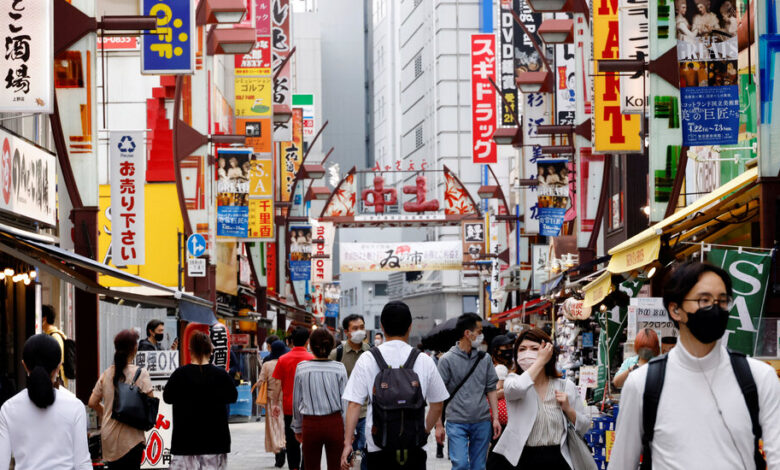Japan Bounces Back to Economic Growth as Coronavirus Fears Recede

TOKYO — Restaurants are full. Malls are teeming. People are traveling. And Japan’s economy has begun to grow again as consumers, fatigued from more than two years of the pandemic, moved away from precautions that have kept coronavirus infections at among the lowest levels of any wealthy country.
Lockdowns in China, soaring inflation and brutally high energy prices could not suppress Japan’s economic expansion as domestic consumption of goods and services shot up in the second three months of the year. The country’s economy, the third largest after the United States and China, grew at an annualized rate of 2.2 percent during that period, government data showed on Monday.
The second-quarter result followed growth of 0 percent — revised from an initial reading of a 1 percent decline — during the first three months of the year, when consumers retreated to their homes in the face of the rapid spread of the Omicron variant.
After that initial Omicron wave burned out, shoppers and domestic travelers poured back onto the streets. Case numbers then quickly galloped back to record highs for Japan, but this time the public — highly vaccinated and tired of self-restraint — has reacted less fearfully, said Izumi Devalier, head of Japan economics at Bank of America.
“After the Omicron wave ended, we had a very nice jump in mobility, lots of catch-up spending in categories like restaurant and travel,” she said.
The new growth report indicates that Japan’s economy may finally be back on track after more than two years of yo-yoing between growth and contraction. Still, the country remains an economic “laggard” compared with other wealthy nations, Ms. Devalier said, adding that consumers, especially older people, “are still sensitive to Covid risks.”
As that sensitivity has slowly declined over time, she said, “we have had this very gradual recovery and normalization from Covid.”
The second-quarter growth came despite stiff headwinds, particularly for Japan’s small- and medium-size enterprises. China’s Covid lockdowns have made it hard for retailers to stock in-demand products like air-conditioners, and for manufacturers to procure some critical components for their goods.
A weak yen and higher inflation have also weighed on companies. Over the last year, the Japanese currency has lost more than 20 percent of its value against the dollar. While that has been good for exporters — whose products have grown cheaper for foreign customers — it has driven up prices of imports, which have already become more expensive because of shortages and supply chain disruptions caused by the pandemic and Russia’s war in Ukraine.
While inflation in Japan — at around 2 percent in June — is still much lower than in many other countries, it has forced some companies to substantially raise prices for the first time in years, potentially dampening demand from consumers accustomed to paying the same amounts year after year.
Japan faces other challenges both at home and abroad. Small- and medium-size enterprises in particular are likely to struggle as pandemic subsidies come to an end and foot traffic to their businesses remains below prepandemic levels.
Additionally, geopolitical tensions are creating greater uncertainty for Japan’s key industries. Frictions between the United States and China over Speaker Nancy Pelosi’s visit to Taiwan this month have raised concerns among Japanese policymakers about possible disruptions to trade. Taiwan is Japan’s fourth-largest trade partner and a critical producer of semiconductors — essential components for Japan’s large automobile and electronics industries.
As for Japan’s overall economic outlook, “short term, momentum is pretty good, but beyond that, we are actually quite cautious,” Ms. Devalier said.
At home, she expects consumption to slow as people adjust to the new normal of living with the pandemic and their enthusiasm for spending dims. Wage growth, which has been stagnant for years, is falling behind inflation, which is likely to affect spending. And, she said, “for manufacturing and exports we expect a slowdown in momentum reflecting the fact that we expect global growth to be weaker.”
Even under ideal conditions, Japan’s domestic consumption is at least a year away from returning to prepandemic levels, said Shinichiro Kobayashi, a senior economist at Mitsubishi UFJ Research and Consulting.
“Next year, we should be in a situation where it’s not necessary to worry about Covid infections and there are no restrictions whatsoever on economic activity,” he said.
By then, he said, Japan will have most likely relaxed restrictions on tourism and business travel from abroad, which have been an additional drag on its economic performance.
But with Omicron cases still climbing, fully returning to normal life this year is “impossible,” he said.